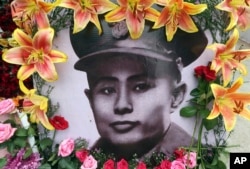Long lines wrapped around the block of downtown Yangon’s historic Secretariat building on Wednesday, with schoolchildren, adults and groups of friends waiting to get a rare glimpse of Myanmar’s history.
Closed to the public most of the year, the sprawling red-brick edifice was built by the British and turned over to the Burmese during independence in 1948. But months before, on July 19, 1947, an act of terrible violence occurred within its walls.
Political rivals gunned down nine people, including Aung San, the father of future Nobel laureate Aung San Suu Kyi. Seventy years later the killings are enmeshed in the national psyche. July 19 is “Martyrs’ Day.”
But as Myanmar emerges from decades of military rule, the legacy of Aung San is coming in for new scrutiny, with some wondering whether the official version of his life fails to capture a far more complex portrait.
“For half a century [there was] the sense of like an official hagiography. He’s a martyr and then his story is taught even in primary school and everyone knows it by heart and they keep on repeating that,” said Khin Zaw Win, director of the Yangon-based think tank the Tampadipa Institute. “But now, well especially now, with the new openness and the new generation and the benefits of things like the internet, of course people are starting to look even deeper.”
The hagiography casts Aung San as an anti-colonial freedom fighter who founded the army and signed the historic “Panglong” peace agreement with ethnic armed groups. His tragic death in his early 30s scuttled chances of peace and an independent federal union.
But the narrative is flawed.
Glossed over are inconvenient details such as Aung San’s role in founding the Burma Communist Party, his ties to the Japanese who occupied the country during World War II – he eventually switched sides to help the Allied forces – his less than perfect relations with ethnic groups, and his political influences.
“It doesn’t mean that Myanmar would have been on a better path if he had been in charge. The rebellions after independence might not have happened, the people after him handled those things very badly. But certain aspects of his life are overlooked,” Khin Zaw Win said.
“He leaned very much towards a kind of centralized authoritarian state. Of course he borrowed heavily from the Leninist-Stalinist models of that day. And there is really quite a bit of doubt whether he would have really tolerated a real multi-party democracy.”
His daughter, Aung San Suu Kyi, who came to power after 2015 elections as part of Myanmar’s transition to democracy, has helped reinforce the official narrative by naming peace talks, launched last year, the “21st Century Panglong” conference. Her party, the National League for Democracy, has also exposed conflicted opinions about Aung San in clumsy attempts to memorialize him.
In March, protests erupted over the party’s proposal to name a bridge after Aung San in Mon State, while other memorials in his honor have been met with disapproval. According to reports, Mon State’s chief minister said the NLD decided that the “biggest and longest bridges” in the country would be named after Aung San, while the MP who proposed the idea dismissed the protestors as narrow-minded and said the project would honor the leader’s sacrifice. The name stayed.
But the fact remains that Aung San was an incredibly important figure in Burmese history, and taking an iconoclastic position on his legacy may not be accurate either.
Matthew Walton, the Aung San Suu Kyi Senior Research Fellow in Modern Burmese Studies at the University of Oxford, said in an email that he could see Aung San as “the ultimate pragmatist.”
“He was single-mindedly focused on independence, so would do whatever he thought would get them there the quickest,” he said. “He was willing to engage with the non-Burman groups and negotiate, but it wasn’t because he saw their cause of autonomy within a wider ‘Burma’ to be just or particularly appropriate, it was because he knew he needed them (and all of them, traditional leaders and younger groups) in order to get independence.”
Walton said there have been so few leaders in the country’s history that have been sympathetic or willing to engage with non-Burmans that “he’s about the best there is.”
He also remains an esteemed and popular figure, as the lines around the Secretariat prove. The company that leased the property with plans for renovation has opened it to the public on July 19 for four years running.
Ma Thandar Win, spokesperson for the Secretariat Conservation Group, said this year visitors can see items preserved after the assassination and stored away at the National Museum. A ring from one of the deceased. Unsmoked cigarettes.
“[They have] never been displayed to the public for 70 years.”









